Bose LIFESTYLE 28 DVD HOME ENTERTAINMENT SYSTEM Manual
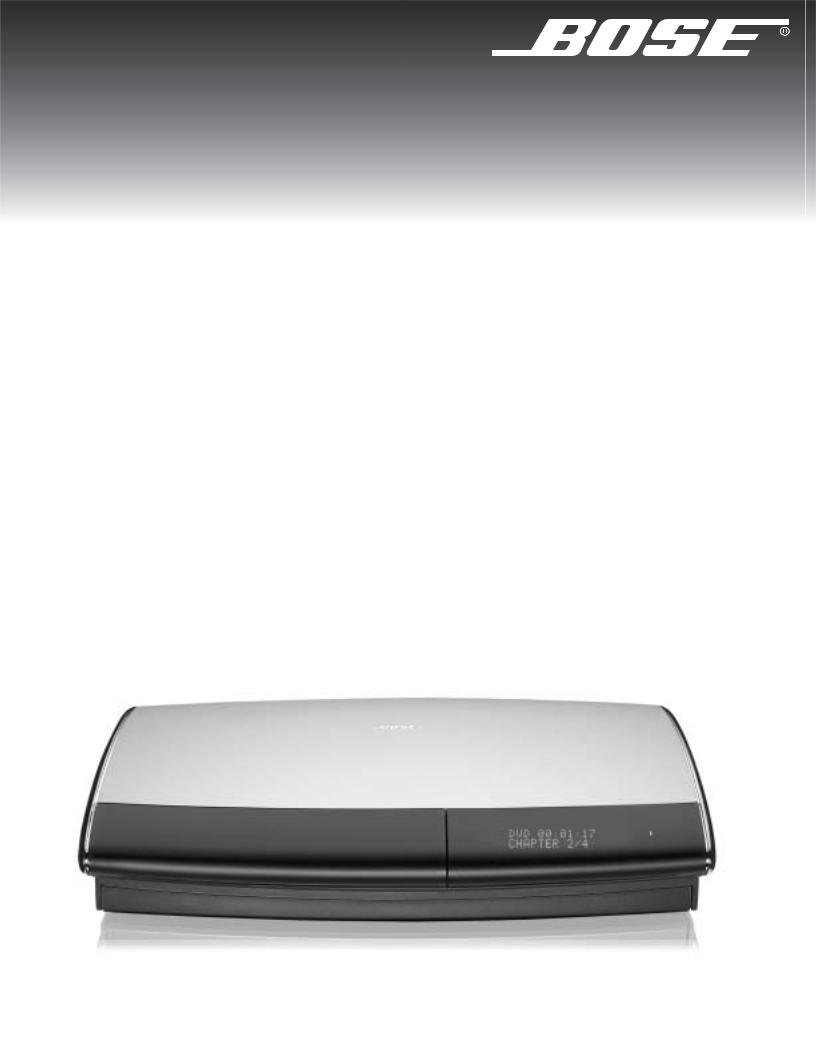
LIFESTYLE® DVD
H O M E E N T E R T A I N ME N T S Y S T E M S w i t h t h e V S - 2 V i d e o E n h a n c e r
Operating Guide
®
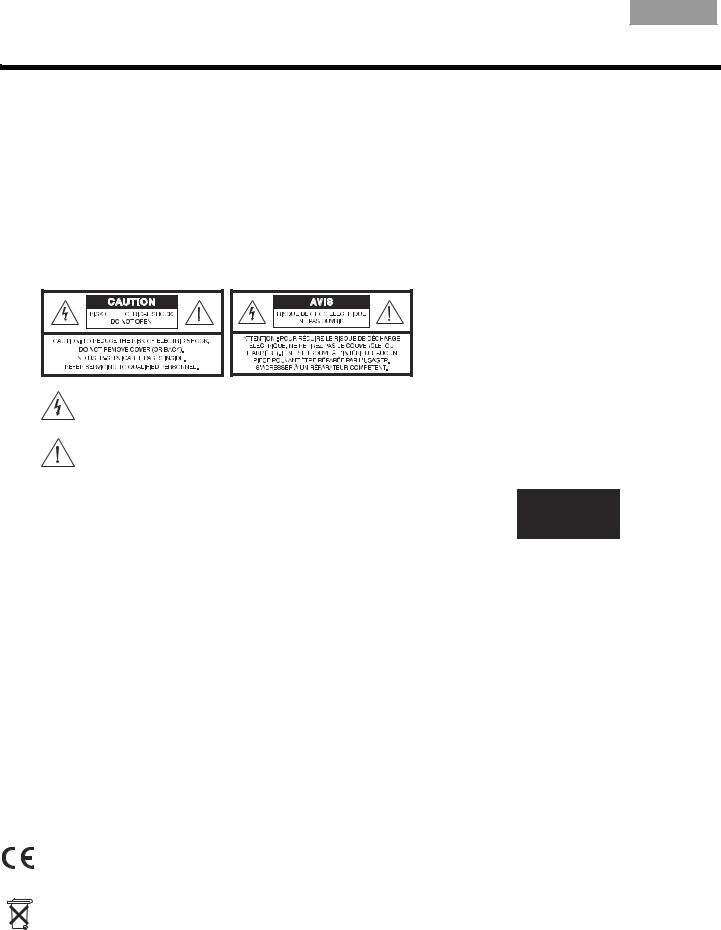
Français Español English
SAFETY INFORMATION
Please read this guide
Please take the time to follow the instructions in this guide carefully. It will help you set up and operate your system properly and enjoy all of its advanced features. Please save this guide for future reference.
Additional safety information
See the additional instructions on the Important Safety Information sheet enclosed in the shipping carton.
 WARNINGS:
WARNINGS:
•To reduce the risk of fire or electrical shock, do not expose the product to rain or moisture.
•The apparatus shall not be exposed to dripping or splashing, and objects filled with liquids, such as vases, shall not be placed on the apparatus. As with any electronic products, use care not to spill liquids into any part of the system. Liquids can cause a failure and/or a fire hazard.
•No naked flame sources, such as lighted candles, should be placed on the apparatus.
The lightning flash with arrowhead symbol within an equilateral triangle alerts the user to the presence of uninsulated, dangerous voltage within the system enclosure that may be of sufficient magnitude to constitute a risk of electrical shock.
The exclamation point within an equilateral triangle, as marked on the system, is intended to alert the user to the presence of important operating and maintenance instructions in this owner’s guide.
Class 1 laser product
This CD/DVD player is classified as a CLASS 1 LASER PRODUCT according to EN 60825-1:1994+A1+A2, IEC60825-1:1993+A1+A2.
 CAUTIONS:
CAUTIONS:
CLASS 1 LASER PRODUCT
KLASSE 1 LASER PRODUKT LUOKAN 1 LASER LAITE KLASS 1 LASER APPARAT
•Use of controls or adjustments or performance of procedures other than those specified herein may result in hazardous radiation exposure. The compact disc player should not be adjusted or repaired by anyone except properly qualified service personnel.
•Make no modifications to the system or accessories. Unauthorized alterations may compromise safety, regulatory compliance, and system performance, and may void the warranty.
Notes:
•Where the mains plug or appliance coupler is used as the disconnect device, such disconnect device shall remain readily operable.
•The product must be used indoors. It is neither designed nor tested for use outdoors, in recreation vehicles, or on boats.
•This product is intended to be used only with the power supply provided.
Class B emissions
•This Class B digital apparatus meets all requirements of the Canadian Interference-Causing Equipment Regulations (Canada only).
•If applicable, the radio communication device incorporated into this apparatus meets all requirements of the Industry Canada standard RSS-310 (Canada only).
This product conforms to the EMC Directive 89/336/EEC and to the Low Voltage Directive 73/23/EEC. The remote control conforms to the RTTE Directive 99/5/EC. The complete Declaration of Conformity can be found at www.Bose.com/static/compliance/index.html.
Please dispose of used batteries properly, following any local regulations. Do not incinerate.
©2007 Bose Corporation. No part of this work may be reproduced, modified, distributed, or otherwise used without prior written permission. For additional copyright, trademark, patent, and licensing information, please refer to pages at the back of this book.
2

English
CONTENTS
|
INTRODUCTION |
|
|
|
|
5 |
|
|
SYSTEM CONTROLS |
|
|
|
|
8 |
|
|
SYSTEM OPERATION |
|
|
|
|
14 |
|
|
CONTROLLING EXTERNAL SOURCES |
|
|
|
|
21 |
|
|
USING SYSTEM MENUS |
|
|
|
|
27 |
|
|
CHANGING SOURCE SETTINGS |
|
|
|
|
35 |
|
|
REFERENCE |
|
|
|
|
41 |
INTRODUCTION |
5 |
Welcome . . . . . . . . . . . . . . . . . . . . . . . . . . . . . . . . . . . . . . . . . . . . . . . . . . . . . . . . . . . . . . . . . . . . . . . . . . . . . . . . . . . |
5 |
Introducing the VS-2 video enhancer . . . . . . . . . . . . . . . . . . . . . . . . . . . . . . . . . . . . . . . . . . . . . . . . . . . . . . . . . . . . . |
5 |
Types of discs you can use with this system . . . . . . . . . . . . . . . . . . . . . . . . . . . . . . . . . . . . . . . . . . . . . . . . . . . . . . . . |
5 |
Glossary of terms . . . . . . . . . . . . . . . . . . . . . . . . . . . . . . . . . . . . . . . . . . . . . . . . . . . . . . . . . . . . . . . . . . . . . . . . . . . . . |
6 |
SYSTEM CONTROLS |
8 |
Remote control buttons . . . . . . . . . . . . . . . . . . . . . . . . . . . . . . . . . . . . . . . . . . . . . . . . . . . . . . . . . . . . . . . . . . . . . . . . |
8 |
Getting good remote control range and response . . . . . . . . . . . . . . . . . . . . . . . . . . . . . . . . . . . . . . . . . . . . . . . . . . . . |
11 |
Media center . . . . . . . . . . . . . . . . . . . . . . . . . . . . . . . . . . . . . . . . . . . . . . . . . . . . . . . . . . . . . . . . . . . . . . . . . . . . . . . . |
12 |
Controls . . . . . . . . . . . . . . . . . . . . . . . . . . . . . . . . . . . . . . . . . . . . . . . . . . . . . . . . . . . . . . . . . . . . . . . . . . . . . . . |
12 |
Display window . . . . . . . . . . . . . . . . . . . . . . . . . . . . . . . . . . . . . . . . . . . . . . . . . . . . . . . . . . . . . . . . . . . . . . . . . |
13 |
SYSTEM OPERATION |
14 |
Initial pointers to get you started . . . . . . . . . . . . . . . . . . . . . . . . . . . . . . . . . . . . . . . . . . . . . . . . . . . . . . . . . . . . . . . . . |
14 |
To turn on your system . . . . . . . . . . . . . . . . . . . . . . . . . . . . . . . . . . . . . . . . . . . . . . . . . . . . . . . . . . . . . . . . . . . |
14 |
To turn on the TV or other external components . . . . . . . . . . . . . . . . . . . . . . . . . . . . . . . . . . . . . . . . . . . . . . . . |
14 |
To watch a DVD . . . . . . . . . . . . . . . . . . . . . . . . . . . . . . . . . . . . . . . . . . . . . . . . . . . . . . . . . . . . . . . . . . . . . . . . . |
14 |
To adjust what you hear or see . . . . . . . . . . . . . . . . . . . . . . . . . . . . . . . . . . . . . . . . . . . . . . . . . . . . . . . . . . . . . |
14 |
Using system sources . . . . . . . . . . . . . . . . . . . . . . . . . . . . . . . . . . . . . . . . . . . . . . . . . . . . . . . . . . . . . . . . . . . . . . . . . |
15 |
Playing a DVD . . . . . . . . . . . . . . . . . . . . . . . . . . . . . . . . . . . . . . . . . . . . . . . . . . . . . . . . . . . . . . . . . . . . . . . . . . . |
15 |
Using DVD parental controls . . . . . . . . . . . . . . . . . . . . . . . . . . . . . . . . . . . . . . . . . . . . . . . . . . . . . . . . . . . . . . . |
16 |
Playing a CD . . . . . . . . . . . . . . . . . . . . . . . . . . . . . . . . . . . . . . . . . . . . . . . . . . . . . . . . . . . . . . . . . . . . . . . . . . . . |
16 |
Using the radio . . . . . . . . . . . . . . . . . . . . . . . . . . . . . . . . . . . . . . . . . . . . . . . . . . . . . . . . . . . . . . . . . . . . . . . . . . |
18 |
Setting, removing, or reassigning radio station presets . . . . . . . . . . . . . . . . . . . . . . . . . . . . . . . . . . . . . . . . . . . |
18 |
Using the headphone jack . . . . . . . . . . . . . . . . . . . . . . . . . . . . . . . . . . . . . . . . . . . . . . . . . . . . . . . . . . . . . . . . . |
19 |
Using the sleep timer . . . . . . . . . . . . . . . . . . . . . . . . . . . . . . . . . . . . . . . . . . . . . . . . . . . . . . . . . . . . . . . . . . . . . |
19 |
CONTROLLING EXTERNAL SOURCES |
21 |
Using your LIFESTYLE® remote with other components . . . . . . . . . . . . . . . . . . . . . . . . . . . . . . . . . . . . . . . . . . . . . . . |
21 |
Setting the remote to control each component . . . . . . . . . . . . . . . . . . . . . . . . . . . . . . . . . . . . . . . . . . . . . . . . . . . . . . |
21 |
For TV control . . . . . . . . . . . . . . . . . . . . . . . . . . . . . . . . . . . . . . . . . . . . . . . . . . . . . . . . . . . . . . . . . . . . . . . . . . . |
21 |
For cable/satellite control . . . . . . . . . . . . . . . . . . . . . . . . . . . . . . . . . . . . . . . . . . . . . . . . . . . . . . . . . . . . . . . . . . |
23 |
For VCR (or other video recorder) control . . . . . . . . . . . . . . . . . . . . . . . . . . . . . . . . . . . . . . . . . . . . . . . . . . . . . |
24 |
For AUX control . . . . . . . . . . . . . . . . . . . . . . . . . . . . . . . . . . . . . . . . . . . . . . . . . . . . . . . . . . . . . . . . . . . . . . . . . |
25 |
Assigning channel control to the TV input device . . . . . . . . . . . . . . . . . . . . . . . . . . . . . . . . . . . . . . . . . . . . . . . |
25 |
USING SYSTEM MENUS |
27 |
Properties that you can adjust . . . . . . . . . . . . . . . . . . . . . . . . . . . . . . . . . . . . . . . . . . . . . . . . . . . . . . . . . . . . . . . . . . . |
27 |
How to enter the System menu . . . . . . . . . . . . . . . . . . . . . . . . . . . . . . . . . . . . . . . . . . . . . . . . . . . . . . . . . . . . . |
27 |
How to make changes . . . . . . . . . . . . . . . . . . . . . . . . . . . . . . . . . . . . . . . . . . . . . . . . . . . . . . . . . . . . . . . . . . . . |
28 |
Audio options . . . . . . . . . . . . . . . . . . . . . . . . . . . . . . . . . . . . . . . . . . . . . . . . . . . . . . . . . . . . . . . . . . . . . . . . . . . . . . . . |
28 |
Video options . . . . . . . . . . . . . . . . . . . . . . . . . . . . . . . . . . . . . . . . . . . . . . . . . . . . . . . . . . . . . . . . . . . . . . . . . . . . . . . . |
29 |
Media center options . . . . . . . . . . . . . . . . . . . . . . . . . . . . . . . . . . . . . . . . . . . . . . . . . . . . . . . . . . . . . . . . . . . . . . . . . . |
31 |
Remote control options . . . . . . . . . . . . . . . . . . . . . . . . . . . . . . . . . . . . . . . . . . . . . . . . . . . . . . . . . . . . . . . . . . . . . . . . |
32 |
DVD Lock options . . . . . . . . . . . . . . . . . . . . . . . . . . . . . . . . . . . . . . . . . . . . . . . . . . . . . . . . . . . . . . . . . . . . . . . . . . . . |
33 |
3

English
CHANGING SOURCE SETTINGS |
35 |
Quick adjustments as you watch or listen . . . . . . . . . . . . . . . . . . . . . . . . . . . . . . . . . . . . . . . . . . . . . . . . . . . . . . . . . . |
35 |
Where to find the list of options . . . . . . . . . . . . . . . . . . . . . . . . . . . . . . . . . . . . . . . . . . . . . . . . . . . . . . . . . . . . . |
35 |
How to change the settings . . . . . . . . . . . . . . . . . . . . . . . . . . . . . . . . . . . . . . . . . . . . . . . . . . . . . . . . . . . . . . . . |
36 |
CD settings options . . . . . . . . . . . . . . . . . . . . . . . . . . . . . . . . . . . . . . . . . . . . . . . . . . . . . . . . . . . . . . . . . . . . . . . . . . . |
37 |
DVD settings options . . . . . . . . . . . . . . . . . . . . . . . . . . . . . . . . . . . . . . . . . . . . . . . . . . . . . . . . . . . . . . . . . . . . . . . . . . |
37 |
Tuner settings options (FM or AM radio) . . . . . . . . . . . . . . . . . . . . . . . . . . . . . . . . . . . . . . . . . . . . . . . . . . . . . . . . . . . |
39 |
TV settings options (for VCR, CBL/SAT, and AUX) . . . . . . . . . . . . . . . . . . . . . . . . . . . . . . . . . . . . . . . . . . . . . . . . . . . |
39 |
REFERENCE |
41 |
System maintenance . . . . . . . . . . . . . . . . . . . . . . . . . . . . . . . . . . . . . . . . . . . . . . . . . . . . . . . . . . . . . . . . . . . . . . . . . . |
41 |
Replacing the remote control batteries . . . . . . . . . . . . . . . . . . . . . . . . . . . . . . . . . . . . . . . . . . . . . . . . . . . . . . . |
41 |
Changing remote control switch settings . . . . . . . . . . . . . . . . . . . . . . . . . . . . . . . . . . . . . . . . . . . . . . . . . . . . . . |
41 |
Protecting and caring for your system . . . . . . . . . . . . . . . . . . . . . . . . . . . . . . . . . . . . . . . . . . . . . . . . . . . . . . . . |
42 |
Setting up a second room with sound . . . . . . . . . . . . . . . . . . . . . . . . . . . . . . . . . . . . . . . . . . . . . . . . . . . . . . . . . . . . . |
43 |
Bose® link-compatible products make it easy . . . . . . . . . . . . . . . . . . . . . . . . . . . . . . . . . . . . . . . . . . . . . . . . . . |
43 |
Bose® link remote switch settings . . . . . . . . . . . . . . . . . . . . . . . . . . . . . . . . . . . . . . . . . . . . . . . . . . . . . . . . . . . |
44 |
Troubleshooting . . . . . . . . . . . . . . . . . . . . . . . . . . . . . . . . . . . . . . . . . . . . . . . . . . . . . . . . . . . . . . . . . . . . . . . . . . . . . . |
45 |
Contacting Customer Service . . . . . . . . . . . . . . . . . . . . . . . . . . . . . . . . . . . . . . . . . . . . . . . . . . . . . . . . . . . . . . . . . . . |
47 |
Limited warranty . . . . . . . . . . . . . . . . . . . . . . . . . . . . . . . . . . . . . . . . . . . . . . . . . . . . . . . . . . . . . . . . . . . . . . . . . . . . . . |
47 |
Accessories . . . . . . . . . . . . . . . . . . . . . . . . . . . . . . . . . . . . . . . . . . . . . . . . . . . . . . . . . . . . . . . . . . . . . . . . . . . . . . . . . |
48 |
Technical information . . . . . . . . . . . . . . . . . . . . . . . . . . . . . . . . . . . . . . . . . . . . . . . . . . . . . . . . . . . . . . . . . . . . . . . . . . |
48 |
4
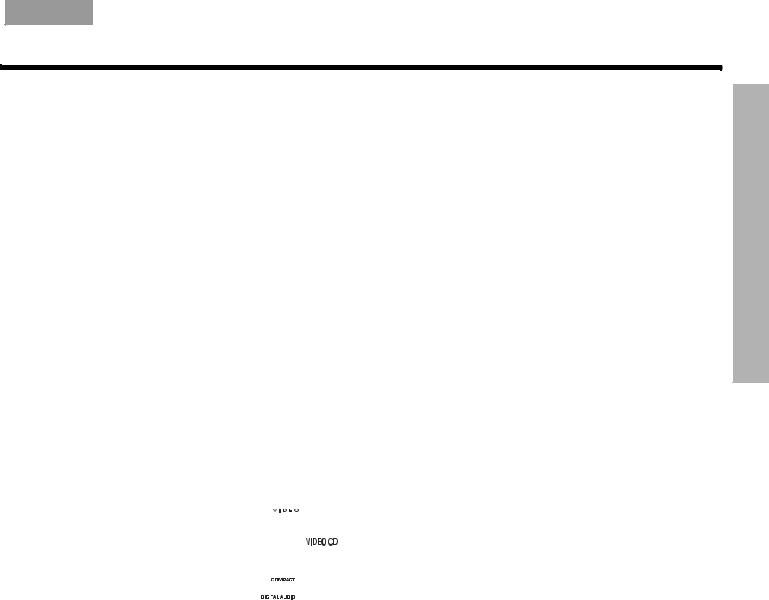
English Español Français
INTRODUCTION
Welcome
Thank you for purchasing a Bose® LIFESTYLE® DVD home entertainment system with HDMITM connectivity and automatic video switching. Through proprietary Bose technologies and innovative LIFESTYLE® system design, this elegant and easy-to-use system delivers superior performance for both music and video program content.
Introducing the VS-2 video enhancer
The Bose VS-2 video enhancer included with your system allows you to connect multiple video sources to your LIFESTYLE® DVD system. With the VS-2 correctly installed, a single button press selects the source video and audio at the same time.
The VS-2 video enhancer:
•Incorporates HDMI (High-Definition Multimedia Interface) technology to help maximize your home theater experience.
•Provides HDMI, component, S-Video, and composite video connections.
•Converts lower-quality video input formats (composite or S-Video) up to higher-quality video output formats (component and HDMI).
•Makes your system compatible with HDTV and progressive scan TV formats.
Types of discs you can use with this system
Your system is engineered to play the disc types listed below, some of which are identified by corresponding logos:
•Video DVDs 
•Video CDs (VCDs) 
•DVD-R or DVD-RW
•Audio CDs 

•SACD content if it is CDcompatible
•CD-R, CD-RW, or CD-ROM
•MP3 CDs created with:
–All tracks burned in a single, closed session
–Use of ISO9660 disc format
–Each file named with an “.mp3” extension and no other periods
–File tags no higher than ID3 (ID3v2)
Any difficulties experienced in playing compatible CDs or DVDs may be related to the rates at which data was recorded to the disc or to the optical characteristics of the recording device used.
Note: Regarding copy protection – Music and other content may be protected by international and domestic copyright laws and may contain specific restrictions on use and/or reproduction. Please respect the rights of the artists and other copyright holders.
NTRODUCTIONI
5
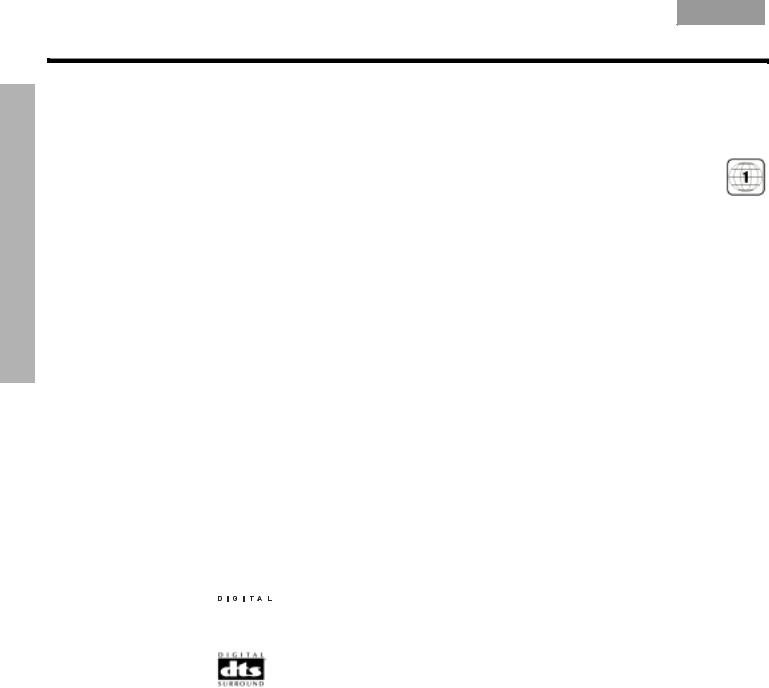
INTRODUCTION
Français Español English
INTRODUCTION
Check DVDs for region number compatibility
For a DVD disc to be compatible with a player, their respective region numbers must match. These numbers are assigned by the geographic region where the player and disc are sold.
You can find the region number for your system on the bottom of the media center. If you have trouble playing a DVD disc, check to see if the region number marked on the disc label or packaging matches the region number of your system. A DVD and media center marked for use in Region 1 should display the symbol at right.
Glossary of terms
AAspect ratio – An expression for the width of the picture relative to the height and seen when as a rectangular TV image. For example, if the aspect ratio is 4:3 (read as 4 by 3), the shape of that picture is 4 units wide by 3 units high. The standard TV aspect ratios are 4:3 and 16:9.
CCD-R, CD-RW – Abbreviations for Recordable (R) and ReWriteable (RW) Compact Disc (CD). Data can be added to a CD-R once only and to a CD-RW more than once.
CD-ROM – The abbreviation for Read Only Memory (ROM) on a Compact Disc (CD), which allows no data to be added.
Chapter – A main division of contents in a DVD title.
Component video – Also called YPbPr, this video signal is split into three parts: luminance and two color signals for considerably better resolution than can be provided by either composite or S-video signals. This more complex signal also requires the use of component connection jacks, which are not available on all televisions or video components.
Composite video – The simplest of three types of video signal, which combines rather than separates brightness (black and white) and color information. It provides the lowest resolution of the three, but is compatible with the broadest range of televisions and other video components and requires a simple video cable connection to RCA jacks.
DDolby Digital – A perceptual coding system for audio, developed by Dolby Laboratories and accepted as an international standard. Dolby Digital is the most common means of encoding multi-channel audio.


 – The logo representing Dolby Digital.
– The logo representing Dolby Digital.
DTS – An abbreviation for Digital Theater Systems, a type of multi-channel surround sound format used on certain CDs and many DVDs.
– The logo representing DTS.
DVD – An abbreviation most commonly known to mean Digital Video Disc or Digital Versatile Disc. The audio/video/data storage system is based on 12-cm optical discs.
DVD-R, DVD+R, DVD-RW, DVD+RW – Abbreviations for Recordable (R) and ReWriteable (RW) Digital Video (or Versatile) Disc (DVD). Data can be added to a DVD-R or +R once only, and to a DVD-RW or +RW more than once.
DVD-ROM – The abbreviation for Read Only Memory (ROM) on a Digital Video (or Versatile) Disc (DVD), which allows no data to be added.
DVD video – A standard for storing and reproducing audio and video on DVD-ROM discs, based on MPEG video, Dolby Digital audio, and other proprietary data formats.
DVR – An abbreviation for Digital Video Recording, sometimes used interchangeably with
PVR, for Personal Video Recording.
HHDMI – An abbreviation for High Definition Multimedia Interface. HDMITM is a de-facto standard interface that delivers clear, all-digital audio and video through a single cable.
6

English Español Français
INTRODUCTION
IIR – An abbreviation for infrared. Pertains to the type of remote that sends/receives commands on an infrared light beam.
LLetterbox – A video format that has an aspect ratio wider than 4:3 and is shown with black bars above and below the picture.
MMP3 – MPEG-1 Layer III audio. This is a compressed audio format that allows the recording of many hours of music on a single CD.
MPEG – An abbreviation for Moving Picture Experts Group, the committee of experts from the audio, video, and computer industries involved in setting standards for compression of moving images.
NNTSC – An abbreviation for National Television System Committee and the label for its video format standard used for televisions in the U.S. and other countries.
PPAL – An acronym for the Phase Alternate Line video format used extensively in Western Europe.
PCM – An abbreviation for Pulse Code Modulation. A common form of digital audio signal.
Progressive Scan – A video format that displays all lines of the picture frame in a single pass and refreshes the TV image 30x/sec. Not compatible with all video displays.
PVR – An abbreviation for Personal Video Recording. Sometimes used interchangeably with DVR for Digital Video Recording but may include non-digital technology, as used in VCRs.
RRF remote – A remote control that transmits commands to a device using radio frequency (RF) signals, which have the ability to penetrate walls, unlike the infrared (IR) signals used by many remote controls.
RDS – A system that displays radio broadcast station and programming information. This feature is available on European systems only.
SSACD – An abbreviation for Super Audio Compact Disc, used for high-resolution digital audio storage on CD-sized discs. New Bose® LIFESTYLE® systems play the CD-compatible portion of such discs, identified by the CD disc logo on the front of the disc.
SCART – A type of jack commonly found on consumer electronics products manufactured for use in Western Europe.
Subtitles – Text that appears at the bottom of the screen during video playback, and which may differ from the language of the on-screen dialog.
S-video – Also called Y/C. A video signal that separates the brightness (black and white) and the color information. S-video provides significantly higher resolution than composite video, but not as high as from component. This type of connection is compatible with many televisions and other video components, and requires use of an S-video cable.
TTeletext – An information retrieval service provided by television broadcast companies in Europe and some other countries, not including the U.S.
VVideo CD – A Compact Disc (CD) that contains a video component.
Videostage® 5 – Bose proprietary decoding circuitry that provides five-channel surround sound performance from varied media – VHS tapes, stereo CDs, even mono TV programs.
YYPbPr – A component analog video signal containing one luminance and two chrominance components. Also referred to as YUV or Y, B-Y, R-Y.
NTRODUCTIONI
7
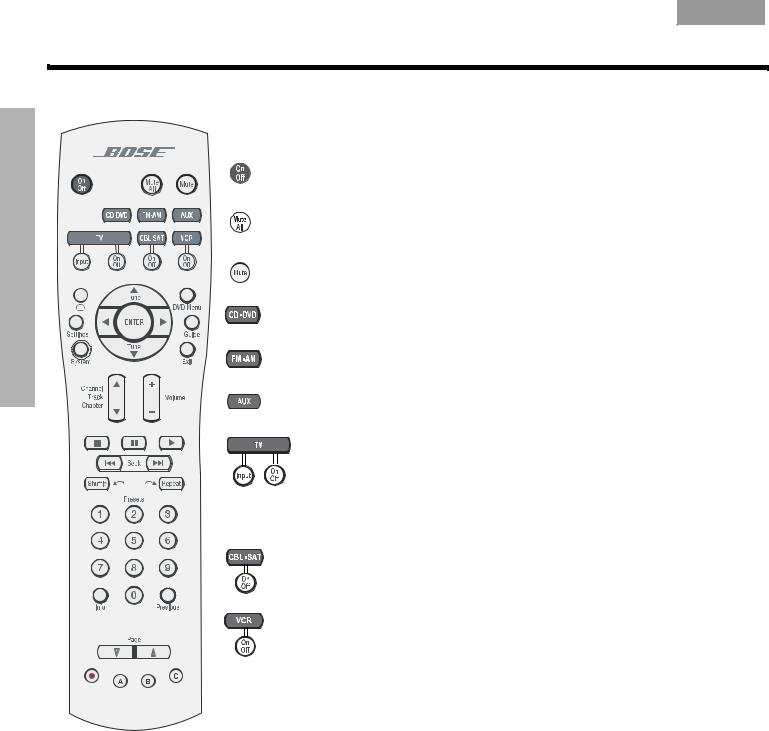
SYSTEM CONTROLS
Français Español English
SYSTEM CONTROLS
Remote control buttons
The advanced radio frequency (RF) remote control provided with this system works from almost anywhere inside your home, with no need to aim it in the direction of the system.
Turns the system on and off. Selects the last used source.
Mutes the volume for all connected speakers (main and in other rooms).
Mutes or unmutes the volume in the current room.
Selects the built-in disc player as source. Turns the system on if it was off.
Selects the built-in FM/AM radio tuner set to the station last selected. Switches between FM and AM when the radio is on. Turns the system on if it was off.
Selects the AUX source connected to your system. Turns the system on if it was off.
TV – Selects the TV source that is connected to your LIFESTYLE® system. Turns the system on if it was off. For more information, see “For TV control” on page 21.
Input – Selects different video inputs on the TV if the remote is set to control it. Enables you to select the TV input connected to the VS-2.
On/Off – Turns the TV on and of, if the remote is set to control your TV.
CBL•SAT – Selects the cable box or satellite receiver that is connected to your
LIFESTYLE system. Turns the system on if it was off.
On/Off – Turns your cable or satellite box on and off, if the remote is set to control it.
VCR – Selects the VCR that is connected to your LIFESTYLE system.
Turns the system on if it was off.
On/Off – Turns your VCR on and off, if the remote is set to control it.
Note: You may set the LIFESTYLE® remote to control your TV, cable or satellite box, or VCR and turn these devices on or off. For details, refer to “Using your LIFESTYLE® remote with other components” on page 21.
8
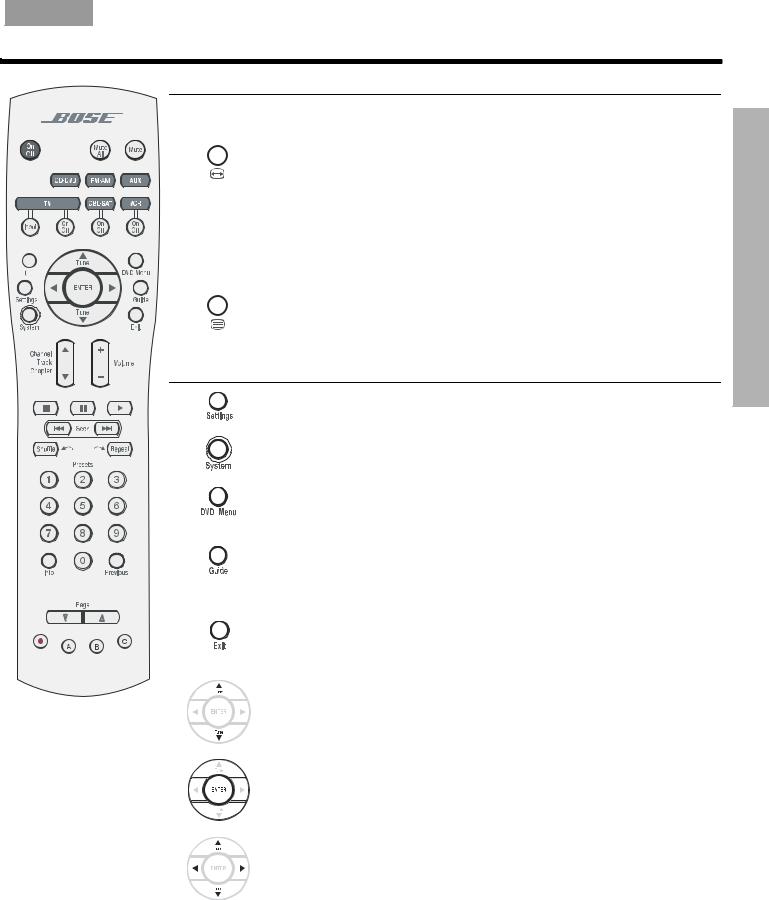
English Español Français
SYSTEM CONTROLS
Depending on the remote you have, the button above the Settings button performs one of the following functions:
If  (Record/ABC* functions) appears below this button and you select a video source:
(Record/ABC* functions) appears below this button and you select a video source:
• When using an HDMITM connection to a widescreen TV (16:9)**, pressing this button skips through Image View settings: Gray Bars, Stretch, Zoom, and Normal (see Image View in TV settings options on page 39).
• For other video connection types and TVs, pressing this button switches the aspect ratio of your TV picture between 4:3 and 16:9 (widescreen). This feature works only if your TV has this function and your LIFESTYLE® remote is set up to control your TV.
If  (Teletext* functions) appears below this button and you select the TV source:
(Teletext* functions) appears below this button and you select the TV source:
• Pressing this button enters the Teletext mode.
• Works in conjunction with the four colored FastText buttons on the remote.
Enters or exits the Settings menu for the current source.
Enters or exits the System menu.
Enters or exits the menu of the DVD disc that is currently loaded.
Enters the main menu of your cable or satellite box, VCR, or DVR (a digital video recorder) or another video recording device.
In Library, provides further details on the search results.
Displays an electronic program guide (if your TV, cable, satellite box or VCR/DVR provides this feature) when the remote is set up to control such components.
Exits the Settings and System menus and the Library and Info screens.
Exits on-screen menus for TV, cable, satellite box, or VCR/DVR (if the remote is set up to control such components).
Tunes the FM/AM radio up or down to the next frequency.
Selects the next or previous item in a menu list.
Confirms the selection of a menu item.
Moves up, down, left, or right in a menu or screen.
ONTROLSC YSTEMS
* See Remote Version in “Remote control options” on page 32.
**The Widescreen TV option must be set to Yes in “Video options” on page 29.
9
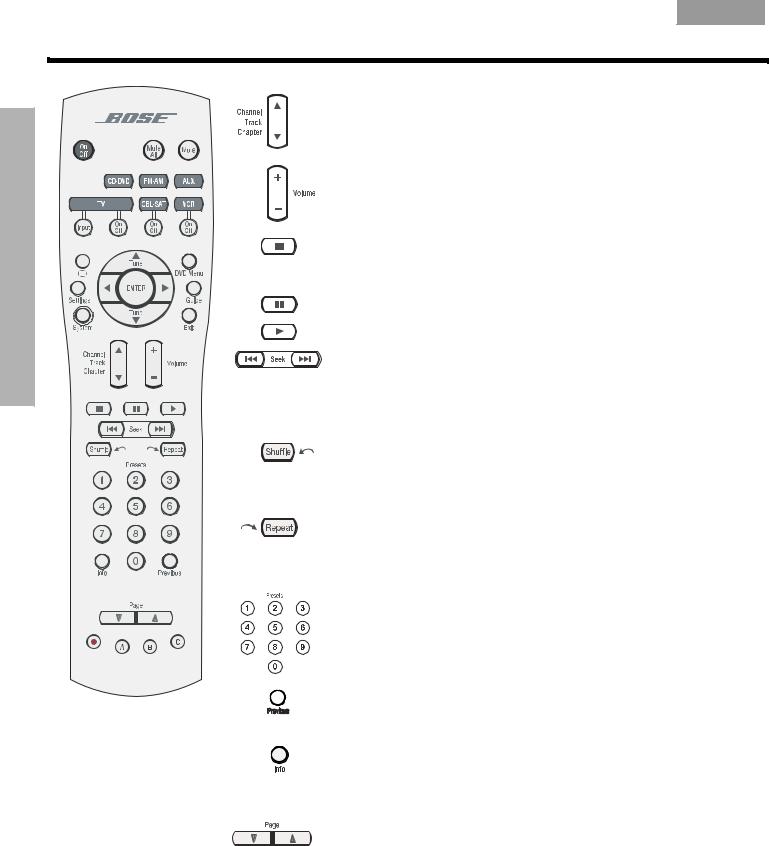
SYSTEM CONTROLS
SYSTEM CONTROLS
Français Español English
Skips backward or forward to the next TV, cable, or satellite channel, CD track, or DVD chapter.
Raises or lowers the volume of the current source.
Pressing + raises the volume and unmutes the source playing (if muted) in the current room only.
Pressing – lowers the volume.
Stops music (except FM/AM) or video play.
For DVDs and VCDs only, the system bookmarks where the disc stopped, so you can resume play there. Pressing again clears the bookmark.
Pauses music (except FM/AM) or video play.
Starts music (except FM/AM) or video play.
Moves backward or forward in video. Displays a control bar to adjust the speed of this movement.
Moves to the previous or next CD track, or strong radio station.
When pressed and held, scans backward or forward through the current CD or MP3 disc.
Randomly plays music from a CD. Pressing again cancels this style of play.
Moves back a few seconds in your DVR (or other digital video recorder) if the LIFESTYLE® remote is set up for this control.
Repeats the current music selection. Pressing again cancels this style of play.
Moves ahead a few seconds in your DVR (or other digital video recorder) if the LIFESTYLE® remote is set up for this control.
Selects a radio station preset, DVD chapter, CD track, or TV channel that corresponds to the numbers pressed.
Skips to the channel last selected on TV, cable, satellite box, or VCR/DVR (if applicable) when the remote is set up to control your components.
Displays or exits the TV, cable, satellite box, or VCR/DVR information on the TV screen, if the remote is set up to control your components.
During MP3 play, removes or restores track information on the media center display.
Moves to the previous (arrow down) or next (arrow up) page in some cable and satellite on-screen menus and guides.
10
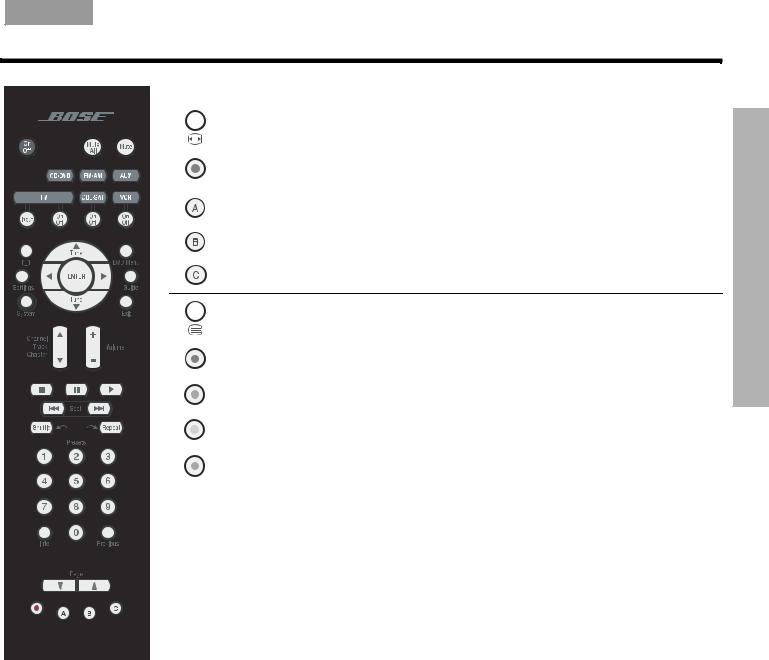
English Español Français
SYSTEM CONTROLS
If your remote has this button* above the Settings button, the four buttons on the bottom of your remote perform the following functions:
In VCR source (or AUX, if a recorder-type device is connected to that input), activates the record function. Not available on remotes set to control Teletext.
In Cable source, makes a selection from the A list.
In Cable source, makes a selection from the B list.
In Cable source, makes a selection from the C list.
If your remote has this button* above the Settings button, the four colored buttons on the bottom of your remote perform the following functions:
In Teletext mode, selects the content labeled red.
In Teletext mode, selects the screen content labeled green.
In Teletext mode, selects the screen content labeled yellow.
In Teletext mode, selects the screen content labeled blue.
* See Remote Version in “Remote control options” on page 32.
Getting good remote control range and response
The cord that connects the power supply to the VS-2 and the VS-2 to the media center contains an antenna for your RF remote. For good range, it is VERY important that you extend this cord to its full length and keep it away from other system cables. Placing the power supply on the floor, well below the media center, puts the cord in a vertical orientation, which is optimum.
Note: When using a plasma screen TV, keeping the media center power supply as far from the TV as is practical improves remote range.
If your system does not respond when you press a button on the remote, it could be time to change the batteries. For information on the type of batteries to use and how to change them, refer to “Replacing the remote control batteries” on page 41.
In some buildings, there may be “dead spots” where remote control signals are not effective. If this happens, move the remote a foot or two and try again. If this does not help, move the media center a few feet to see if a new location provides better response.
If the batteries are not dead and your efforts to avoid dead spots are in vain, you may need an antenna extender. To contact Bose for more information, or to order the extender, refer to the contact list included with the system.
ONTROLSC YSTEMS
11
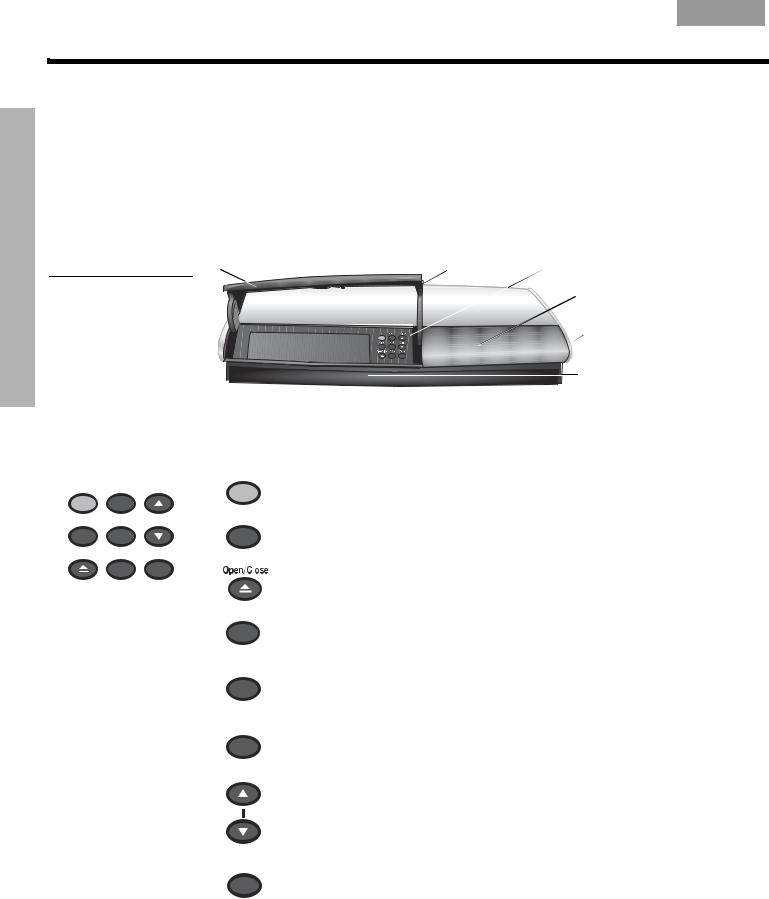
SYSTEM CONTROLS
Français Español English
SYSTEM CONTROLS
Media center
The disc tray and system controls are located under the front panel door of the media center. To the right of the system controls is the display window (Figure 1).
 CAUTION: Pressing the Open/Close button on the media center is the best way to open and retract the disc tray. DO NOT press on the tray to make it retract or exert pressure on the front of the tray while it is moving. Doing so can cause the disc player to malfunction.
CAUTION: Pressing the Open/Close button on the media center is the best way to open and retract the disc tray. DO NOT press on the tray to make it retract or exert pressure on the front of the tray while it is moving. Doing so can cause the disc player to malfunction.
An IR (infrared) signal emitter, located under the disc tray, enables you to control other components using the LIFESTYLE® remote. Avoid blocking this emitter, so its signal will have a clear path to other components or reflective surfaces in the room.
Figure 1 Front panel door – lifts up Disc tray  Controls
Controls
Front view of the media |
Display window |
|
center |
||
|
||
|
Headphone jack |
|
|
IR emitter |
Controls
Four of the media center control panel buttons provide similar control to buttons on the remote control. The other five offer unique functionality.
|
|
|
|
|
On/Off |
|
On/Off |
Source |
Volume |
|
|
||
All Off |
Enter |
|
|
|
All Off |
|
|
|
|
||||
Open/Close |
Erase |
Store |
|
|
||
|
|
|
|
|
|
|
|
|
|
|
|
|
|
|
|
|
|
|
|
|
Source
Enter
Erase
Volume
Store
Turns the system on or off in the main room only. Selects the source last used when it turns on the system.
Turns off the system and all connected speakers (in all rooms).
Opens and closes the disc tray.
Selects the next available sound source in sequence.
Initiates DVD play when that option is selected from DVD menu options that appear on the TV screen.
In combination with the Store button, advances through and selects system settings on the media center display.
Removes a radio station preset.
Raises the volume of the system and unmutes the speakers (if they are muted).
Lowers the volume of the system but does not unmute the source.
When the system is off, resets the remote control house code.
In combination with the Enter button, advances through and selects system settings on the media center display.
12
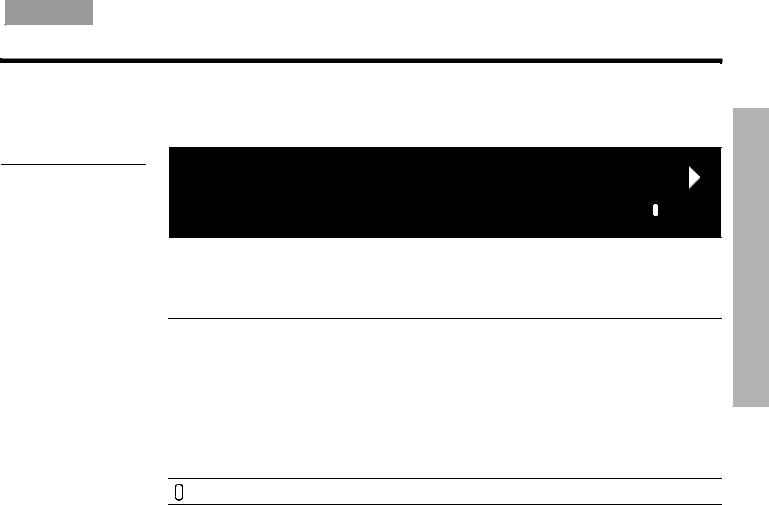
English Español Français
SYSTEM CONTROLS
Display window
Figure 2
Sample of information that appears on the media center display
The media center display window indicates the state of the system, including which source is playing, program details, and what option, if any, is selected (Figure 2).
S T O R E D 0 : 2 2 P 1 |
|
T R A C K 6 / 1 0 |
C D 7 |
When Settings menu items or messages appear in the display, they may scroll to reveal information that does not fit in the two lines available.
Light indicators
Sleep |
Shows when the system is set to shut down automatically. |
|
|
Settings |
Shows when the source Settings menu is selected. |
|
|
Shuffle |
Shows when tracks from a CD, Playlist, or Library search are playing in random order. |
|
|
Repeat |
Shows when the track playing is set to play again. |
|
|
Disc |
Shows when a selected action applies to the tracks on a disc. |
|
|
Track |
Shows when a selected action applies to one track only. |
Lights briefly when a remote control command is received.
ONTROLSC YSTEMS
13

SYSTEM OPERATION
Français Español English
SYSTEM OPERATION
Initial pointers to get you started
Scanning the following tips may prove worthwhile before using your system.
Note: For information on how to set the remote to operate other components, refer to “Using your LIFESTYLE® remote with other components” on page 21.
To turn on your system
•Press the On/Off button on the remote control. OR
•Press the media center On/Off button. OR
•Press the CD/DVD, FM/AM, TV, CBL/SAT, or AUX remote button. This turns on the system and selects the source at the same time.
To turn on the TV or other external components
You can use your LIFESTYLE® remote to control externally connected components such as your TV, cable/satellite receiver, or VCR. Refer to “Setting the remote to control each component” on page 21.
After setting up your remote:
•Turn on the system.
•Press the remote control button for the source you want.
To watch a DVD
•Turn on the system.
•Be sure to select the video input on your TV that connects to the VS-2 video enhancer. Use the LIFESTYLE® remote control Input button (just below the TV source button).
•Put a DVD in the media center tray.
•Press the CD/DVD button on the remote.
To adjust what you hear or see
•To correct sound problems (unexpected boominess, harshness, thinness, or reverberation) take time to run the ADAPTiQ® audio calibration program, if you have not done so.
•For lasting adjustment to system operation (for audio, video, media center, remote control, or DVD lock), use the System menus. For details on the changes you can make, refer to “Properties that you can adjust” on page 27.
•For temporary adjustments to the particular source playing (like the number of speakers engaged or the turn-off timer setting), use the on-screen Settings menus. For details on the changes you can make, refer to “Quick adjustments as you watch or listen” on page 35.
14

English Español Français
SYSTEM OPERATION
Using system sources
For instructions on selecting and playing system sources, refer to buttons on the
LIFESTYLE® remote control unless otherwise specified.
Playing a DVD
1.Turn on your TV.
2.Press CD/DVD to select the DVD player. If the system is off, this will turn it on.
3.On the media center, lift the door and press the Open/Close button to expose the disc tray.
4.Insert a DVD into the tray (label side up). Be sure the DVD is clean. If not, refer to “Protecting and caring for your system” on page 42.
5.On the media center, press the Open/Close button again to retract the disc tray.
6.Press Play to begin DVD play.
You may need to press Play more than once. On most DVDs, the option to play the main feature is just one of several on-screen selections offered.
Note: Not all DVDs offer the same features. You can choose subtitles only if the disc provides subtitle information.
Your remote control options
When you want to:
Pause a DVD movie…
Resume play…
Stop a DVD movie…
Skip to the next chapter…
Skip to the previous chapter…
Repeat a chapter…
Search backward or forward…
Select a different option offered on the DVD…
Press:
 .
.
 again, or
again, or  .
.
 .
.
Then  to resume play where the movie stopped. Or,
to resume play where the movie stopped. Or,  twice to stop and reset.
twice to stop and reset.
Then  to restart at the beginning of the DVD.
to restart at the beginning of the DVD.
up.
down twice.

 while the chapter you want to repeat plays.
while the chapter you want to repeat plays.
 for the motion rate control bar to appear. Press again to adjust the rate of the search and set the direction.
for the motion rate control bar to appear. Press again to adjust the rate of the search and set the direction.
to view the menu shown at the beginning of the 


 DVD. Use the left, right, up, or down arrows to reach the menu item you want, and press Enter to make that selection.
DVD. Use the left, right, up, or down arrows to reach the menu item you want, and press Enter to make that selection.
PERATIONO YSTEMS
15
